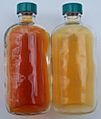Le Chatelier's principle facts for kids
Le Châtelier's principle is a rule in chemistry and physics. It helps us understand how a balanced system reacts when something outside tries to change it.
Contents
Understanding Le Châtelier's Principle
This principle explains how a system in equilibrium will shift to work against any changes made to it. Think of it like a seesaw that tries to stay level. If you push one side, the seesaw will try to push back to get balanced again. This idea is often seen in chemical reactions that can go both ways, called reversible reactions. In these reactions, new substances (products) are made at the same speed that they turn back into the original substances (reactants). Scientists and industries use this principle to make more of the products they want by shifting the balance in a reaction.
How Concentration Changes Equilibrium
Imagine you have a recipe, and you add more of one ingredient (a reactant). According to Le Châtelier's principle, the reaction will try to use up that extra ingredient. So, the balance will shift to make more products. This helps get rid of the extra reactant and brings the system back to a new balance. In the same way, if you add more of the finished product, the reaction will shift back towards making more of the original ingredients.
How Pressure Changes Equilibrium
Pressure mostly affects reactions involving gases. If you increase the pressure on a system, the system will try to lower that pressure. It does this by shifting the balance towards the side of the reaction that has fewer gas molecules. Fewer gas molecules take up less space, which helps reduce the pressure. If you decrease the pressure, the system will shift to the side with more gas molecules to try and increase the pressure.
How Temperature Changes Equilibrium
When you change the temperature of a system, the equilibrium will also shift.
- If you increase the temperature, the system will try to cool itself down. It does this by favoring the side of the reaction that absorbs heat. This type of reaction is called endothermic. It uses up the extra heat you added.
- If you decrease the temperature, the system will try to warm itself up. It does this by favoring the side of the reaction that releases heat. This type of reaction is called exothermic.
Images for kids
-
The reversible reaction N2O4(g) ⇌ 2NO2(g) is endothermic, so the equilibrium position can be shifted by changing the temperature. When heat is added and the temperature increases, the reaction shifts to the right and the flask turns reddish brown due to an increase in NO2. This demonstrates Le Chatelier's principle: the equilibrium shifts in the direction that consumes energy. When heat is removed and the temperature decreases, the reaction shifts to the left and the flask turns colorless due to an increase in N2O4: again, according to Le Chatelier's principle.
See also
 In Spanish: Principio de Le Châtelier para niños
In Spanish: Principio de Le Châtelier para niños


